Scarlet Macaw
Ara macao
Like many parrots, the scarlet macaw is capable of vocal mimicry.
Advertisement
Scarlet Macaw Scientific Classification
- Kingdom
- Animalia
- Phylum
- Chordata
- Class
- Aves
- Order
- Psittaciformes
- Family
- Psittacidae
- Genus
- Ara
- Scientific Name
- Ara macao
Read our Complete Guide to Classification of Animals.
Scarlet Macaw Conservation Status
Scarlet Macaw Facts
- Fun Fact
- Like many parrots, the scarlet macaw is capable of vocal mimicry.
- Estimated Population Size
- 20,000 - 50,000
- Biggest Threat
- Habitat destruction
- Most Distinctive Feature
- Brightly colored plumage
- Wingspan
- 3ft
- Incubation Period
- 3-4 weeks
- Habitat
- Rainforests
- Predators
- Jaguars, eagles, hawks, monkeys, and snakes
- Diet
- Omnivore
- Favorite Food
- Fruit, nuts, nectar, and insects
- Type
- Bird
- Common Name
- Scarlet macaw
- Number Of Species
- 1
- Location
- Central and South America
- Nesting Location
- Upper canopy
- Age of Molting
- 3-4 months
View all of the Scarlet Macaw images!

Prized for its exceptional beauty and astonishing vocal mimicry, the scarlet macaw is one of the most iconic and beloved parrots around the world.
They make their home in the dense rainforests of the Americas, where their loud squawking can be heard for miles around. But despite being a species of least concern, the destruction of the American rainforests is threatening to put this macaw in danger.
4 Amazing Scarlet Macaw Facts
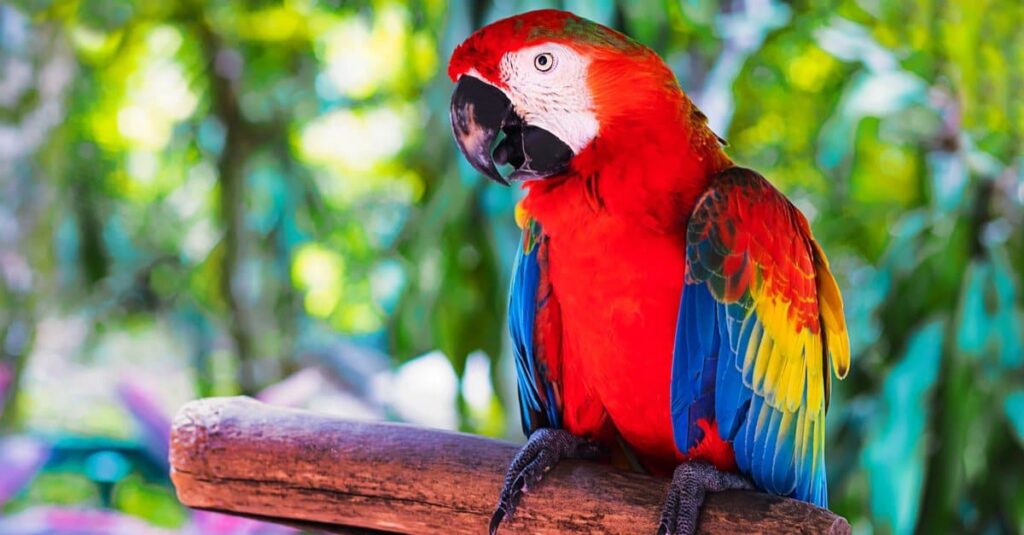
The exotic pet industry has a high demand for the scarlet macaw, and the cost of a single bird typically exceeds $1,000.
©Daria Photostock/Shutterstock.com
- The scarlet macaw is very popular in the exotic pet trade. The price of one bird is usually more than $1,000.
- The scarlet macaw has hollow bones that aid them in flight.
- One of the more unusual facts is that the scarlet macaw has sometimes been observed consuming clay. It is not entirely understood why they exhibit this behavior, but the clay might help them neutralize toxins in their diet.
- The practice of raising captive macaws dates back more than a thousand years. Their feathers were used for ceremonial purposes by ancient Americans. Today, scarlet macaws are raised in captivity and then released back into the wild for conservation purposes.
Evolution and Origins
The scarlet macaw is indigenous to the tropical regions of Central and South America and prefers to inhabit moist evergreen forests situated at elevations between 1,000 and 3,000 feet, primarily residing in the upper layers and canopies of trees in their natural habitat.
Through the use of high-accuracy accelerator mass spectrometry (AMS) to date skeletal remains of scarlet macaws (Ara macao), researchers have obtained the initial direct proof originating from Chaco Canyon located in northwestern New Mexico, that Pueblo individuals acquired these Neotropical birds from Mesoamerica, dating as far back as around 900-975 AD.
The macaw family encompasses scarlet macaws, which can be categorized into two subtypes, and are capable of imitating human speech, while being the biggest species of parrot and identified by their brightly colored feathers; despite the reduction in their habitat, they are not considered an endangered species.
Where to Find the Scarlet Macaw
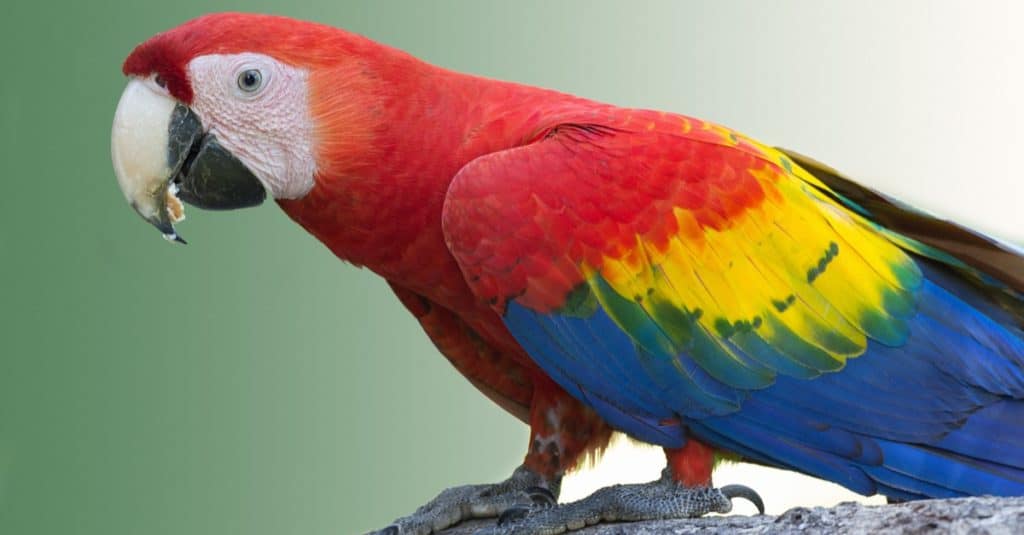
The scarlet macaw is naturally found only in the rainforests of Mexico, Central America, and South America, with a significant population residing in the Amazon basin.
©Angel DiBilio/Shutterstock.com
The scarlet macaw is endemic to the rainforests of Mexico, Central America, and South America, with the greatest concentration living in the Amazon basin.
Scarlet Macaw Nests
The scarlet macaw makes its nest in the hollow areas of the upper canopies of large trees.
Scientific Name
The scientific name of the scarlet macaw is Ara macao (the now obsolete Portuguese word from which the name macaw derives).
Appearance

Scarlet Macaws are curious, strong-willed, and highly trainable. It is one of the most intelligent bird species in the world and able to mimic words and sounds and learn tricks in captivity.
©Ondrej Prosicky/Shutterstock.com
The scarlet macaw is a large bird with a strong, curved beak and brightly colored plumage. It is composed of three distinctive color bands: red on the head and shoulders, yellow on the back and mid-wing feathers, and blue on the wingtips and tail. The face has a patch of black and white skin as well.
The scarlet macaw is one of the largest parrots in the world. It measures about 33 inches on average from head to tail; half to a third of this is composed of just the tail. The two sexes are almost completely similar in size and appearance, but males tend to have slightly larger tail feathers and bills.
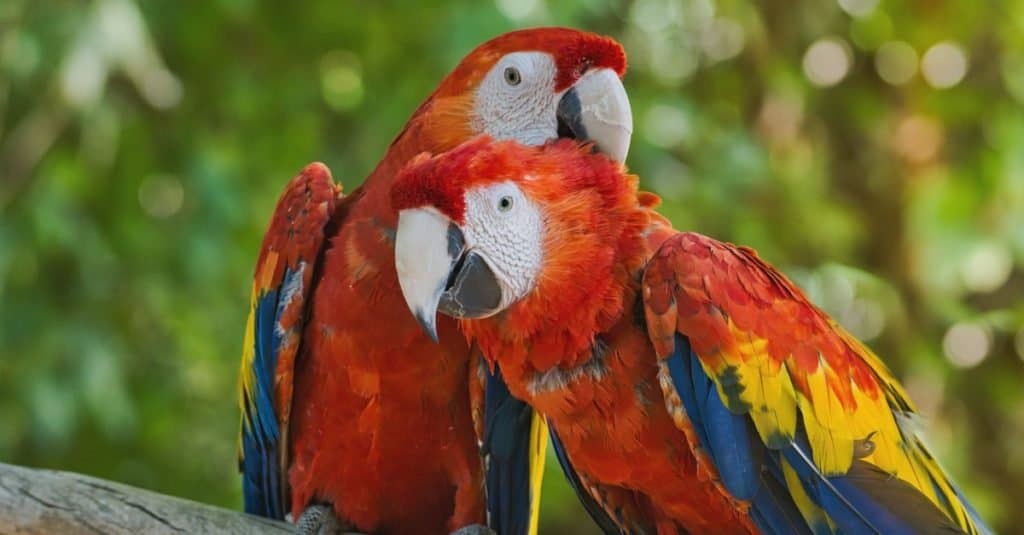
The scarlet macaw possesses a sizeable physique, along with a sturdy, hooked bill, and vividly colored feathers.
©Amy Newton-McConnel/Shutterstock.com
Behavior
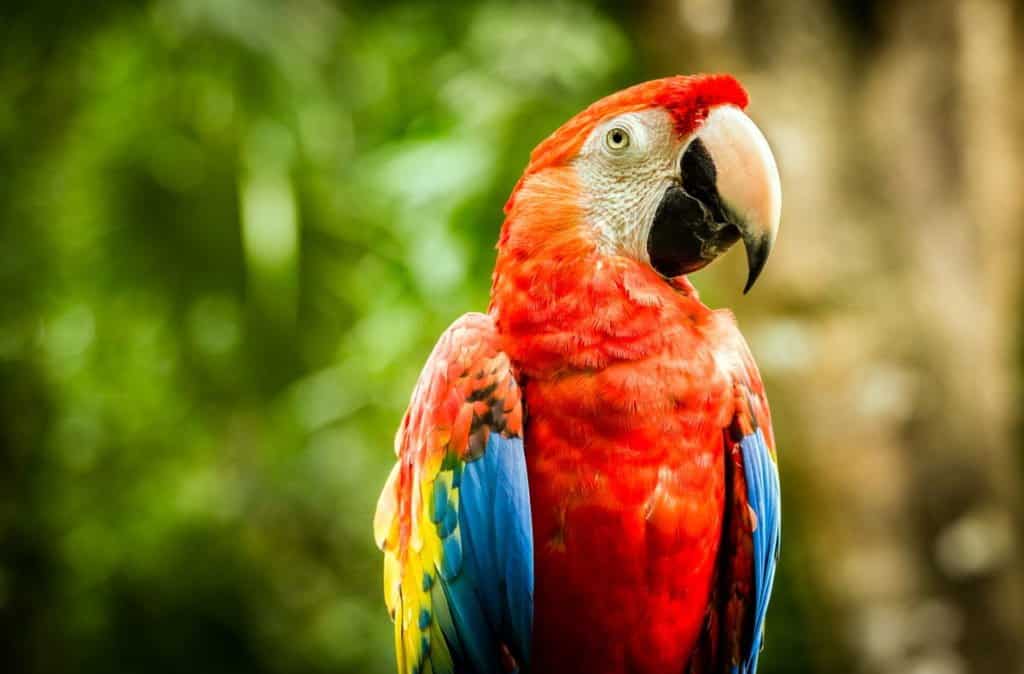
The macaw’s social structure primarily centers around nuclear families consisting of a mating couple and their several offspring; moreover, they gather in large groups during the night for communal roosting.
©Maciej Czekajewski/Shutterstock.com
The macaw’s social life revolves around small family units consisting of a mating pair and multiple offspring; they also congregate together in large flocks at night to sleep. These birds show affection for their mates by mutual licking and preening, which can last for hours at a time. They also have the ability to communicate with each other through a large variety of different sounds and postures. Despite their reputation for mimicry, the standard sound of the scarlet macaw is a harsh screeching, squawking, or screaming that can carry for miles.
Among the most interesting facts is that the beak functions as a vital instrument of the bird’s survival. It enables the bird to climb trees like a third limb and also crack open tough shells. The macaw has special structures in its mouth that can hold food against the tongue and grind down hard shells and skin.
Diet
The scarlet macaw is an omnivore; it can eat either meat or plant matter. But perhaps a more accurate description is an herbivore with some specialized carnivorous tendencies.
What does the scarlet macaw eat?
These birds are major consumers of fruits, seeds, nuts, and nectar; it then supplements this with insects and larvae during the breeding season for extra protein. It is believed that these birds gain a competitive advantage over other species by being able to peel away the tougher skin and pulp of unripened fruits with their large, powerful beaks.
Its competitors would need to wait until the fruit has ripened before feeding. The bird may consume a lot of toxic plant matter throughout the day; hence why it’s been speculated that the macaw eats clay to counteract the toxins.
Predators and Threats
The number of scarlet macaws appears to be in decline from the loss of the rainforests due to logging and land clearing. This loss is bolstered by the frequency with which it’s poached for sale on the international pet trade and, less commonly, hunted for the value of its feathers and meat.
What eats the scarlet macaw?
An adult scarlet macaw is sometimes preyed upon by jaguars, eagles, and hawks. Baby macaws are also put in danger by snakes, monkeys, and other carnivores.
Reproduction, Babies, and Lifespan
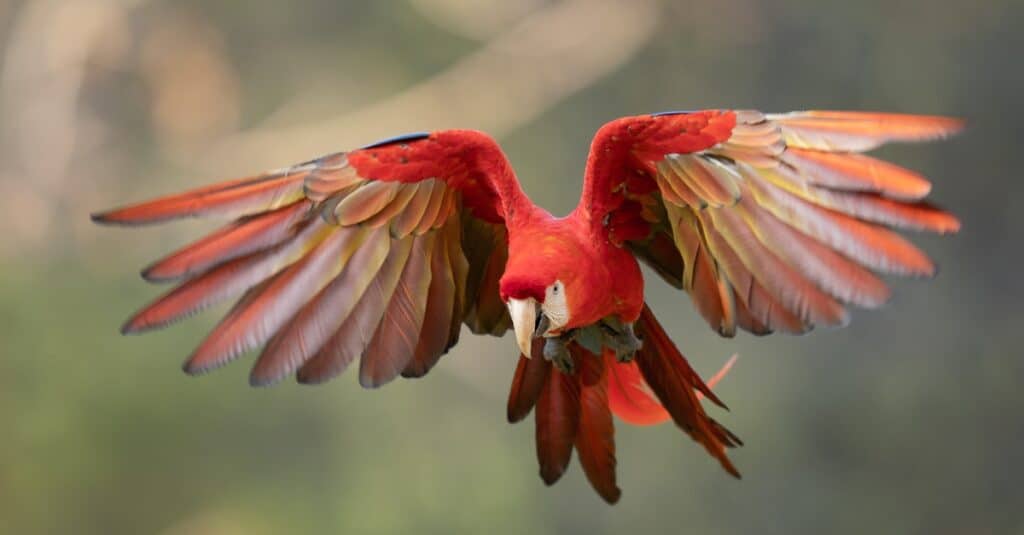
These birds utilize a mating approach that involves developing a highly intimate bond between partners that endures throughout their lifetime.
©iStock.com/sduben
These birds’ mating strategy involves the formation of very close pair bonds that last for life. This allows both parents to maintain a nest and invest enormous resources into the care of each baby. After mating, the female produces a clutch of two to four white eggs that need to be incubated by her for about three to four weeks. The parents feed the baby chicks by regurgitating liquefied food (sometimes up to 15 feedings a day).
The chicks will grow their full-flight feathers in about three or four months, but they won’t actually leave the nest until about one or two years of age, perhaps because of the extra time it requires to teach the young the nuances of macaw life. The couple won’t reproduce again until the previous chicks have left the nest.
These birds will begin reproducing on their own after about three to four years. They typically have a lifespan of some 40 to 50 years in the wild, but some have been known to survive up to 75 years in captivity.
Population

The scarlet macaw (Ara macao) flying through the forest with green background.
©Karel Bartik/Shutterstock.com
It is estimated that there are some 20,000 to 50,000 of these birds remaining in the wild. The IUCN Red List currently classifies this as a species of least concern, but habitat loss has caused numbers to decline precipitously. Already, the northern populations are becoming endangered in Mexico, Panama, Belize, and Costa Rica, and it is almost completely gone from El Salvador.
Some of the Amazonian populations are under strain as well. In order to halt this decline, it will be necessary to slow the loss of rainforests and engage with local communities to end poaching. This will need to be done in conjunction with the reintroduction of macaws into former parts of their territory.
View all 293 animals that start with SScarlet Macaw FAQs (Frequently Asked Questions)
Does the scarlet macaw migrate?
No, this bird has a dedicated roosting site, where it remains for much of its life.
How many eggs does the scarlet macaw lay?
The scarlet macaw will lay two to four eggs at a time. It breeds once every year or two.
How fast does scarlet macaw fly?
This bird has a top speed of approximately 35 miles per hour.
What is the scarlet macaw’s wingspan?
The scarlet macaw has a wingspan of about 3 feet.
When do scarlet macaws leave the nest?
The scarlet macaw will remain with the parents for the first year or two.
What is the price of a scarlet macaw?
The price of a scarlet macaw can easily exceed $1,000.
Are scarlet macaws good pets?
If properly raised and socialized from an early age, scarlet macaws are usually friendly and mild-tempered enough birds to make good housemates. However, as among the largest of all parrots, they do require a great deal of space, and their loud, frequent squawking may be unpleasant for the ears (and may even pierce through walls and annoy neighbors). Owners would need to devote a lot of time and effort to its care.
Can scarlet macaws talk?
The scarlet macaw can typically learn between five to 10 words and phrases at a time, but it’s not quite as adept at vocal mimicry as some other members of the macaw family.
How many scarlet macaw are left?
It is estimated that no more than 50,000 macaws are alive today.
What do scarlet macaws eat?
The scarlet macaw eats fruits, nuts, and nectars, sometimes supplementing this with insects for the breeding season.
What are the differences between scarlet macaws and green winged macaws?
The key differences between green-winged macaws and scarlet macaws can be found in their feather colors and size.
Thank you for reading! Have some feedback for us? Contact the AZ Animals editorial team.
Sources
- Animal Diversity Web, Available here: https://animaldiversity.org/accounts/Ara_macao/
- U.S. Fish & Wildlife, Available here: https://www.fws.gov/international/scarlet-macaws.html
- Britannica, Available here: https://www.britannica.com/animal/macaw
- Switch Zoo, Available here: https://switchzoo.com/profiles/scarletmacaw.htm

















